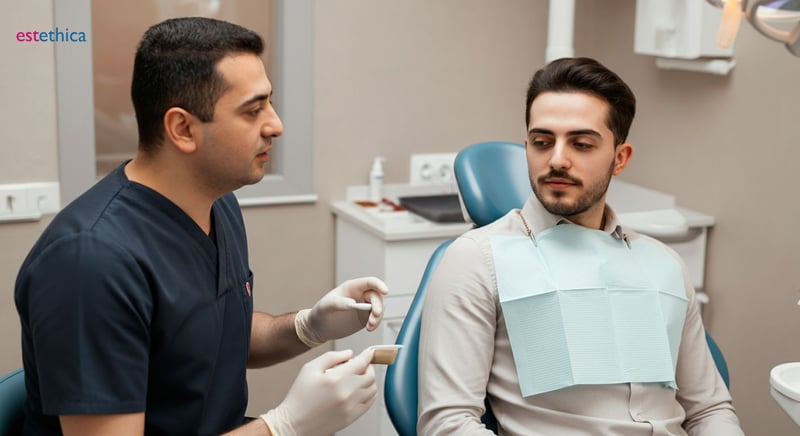Gum Recession Explained: Causes, Symptoms, and Effective Treatments
Discover everything about gum recession, from causes to treatment solutions with expert insights.
Gum recession is a common dental issue affecting individuals worldwide. Characterized by the pulling back of the gum tissue, it exposes the roots of teeth, which can lead to increased sensitivity and potential tooth loss. Understanding what causes gum recession, recognizing the symptoms early, and knowing the treatment options available can empower individuals to take proactive steps for better dental health.
What Is Gum Recession and Why Does It Happen?
Understanding the Causes of Gum Recession
Gum recession is a dental condition where the gum tissue surrounding the teeth wears away, exposing more of the tooth or its root. This condition can be attributed to several factors, including periodontal disease, aggressive tooth brushing, and genetic predispositions. Understanding these causes is crucial for effective prevention and treatment.
- Periodontal Disease: This bacterial infection damages the gum tissue and supporting bone, leading to gum recession. Regular dental check-ups can help in early detection and management.
- Aggressive Brushing: Brushing teeth too hard or using a hard-bristled toothbrush can wear down the gums. Opting for a soft-bristled toothbrush and gentle brushing technique can prevent this.
- Genetic Factors: Some individuals are genetically predisposed to gum recession. Family history can play a significant role, making it important to maintain vigilant dental care practices.
Each of these causes requires a tailored approach to prevention and treatment, emphasizing the importance of personalized dental care.
Steps to Prevent Gum Recession
- Maintain Proper Oral Hygiene: Regular brushing and flossing help remove plaque and prevent gum disease.
- Use the Right Tools: Choose a soft-bristled toothbrush and fluoride toothpaste to protect your gums.
- Regular Dental Visits: Schedule routine check-ups to monitor gum health and catch any issues early.
By following these steps, individuals can significantly reduce the risk of gum recession and maintain optimal gum health.

Identifying the Symptoms of Gum Recession Early
Recognizing Early Signs of Gum Recession
Early identification of gum recession is crucial for effective treatment. Symptoms often include tooth sensitivity, visible roots, or teeth that appear longer than normal. Recognizing these signs early can prevent further dental complications.
- Tooth Sensitivity: Increased sensitivity to hot or cold foods may indicate exposed roots due to receding gums.
- Visible Roots: As gums recede, the roots of the teeth become more visible, which can lead to discomfort.
- Longer Teeth Appearance: Teeth may appear longer as the gum tissue pulls back, exposing more of the tooth structure.
These symptoms can be subtle, making regular dental check-ups essential for early detection and management.
Steps to Address Gum Recession Symptoms
- Consult a Dentist: Seek professional advice if you notice any symptoms of gum recession.
- Adopt Gentle Oral Care: Use a soft-bristled toothbrush and gentle brushing techniques to protect your gums.
- Consider Professional Treatments: Treatments such as scaling and root planing can help manage gum recession effectively.
Addressing these symptoms promptly can help maintain gum health and prevent further dental issues.

Effective Home Remedies for Gum Recession Treatment
Natural Approaches to Manage Gum Recession
Managing gum recession at home can be effective with the right natural remedies. These methods focus on improving gum health and alleviating symptoms without professional intervention. However, it's crucial to consult a dentist for comprehensive care.
- Oil Pulling: This ancient practice involves swishing oil, such as coconut or sesame, in the mouth to reduce bacteria and promote gum health.
- Saltwater Rinses: Rinsing with warm saltwater can soothe inflamed gums and help in reducing bacteria.
- Soft-Bristled Toothbrushes: Using a soft-bristled toothbrush minimizes gum irritation and prevents further recession.
These remedies can complement professional treatments, offering a holistic approach to gum recession management.
Implementing Home Remedies Effectively
- Regular Oil Pulling: Practice oil pulling daily for about 15-20 minutes to maximize its benefits.
- Consistent Saltwater Rinses: Use saltwater rinses twice a day to maintain gum health and reduce inflammation.
- Gentle Brushing Technique: Brush gently with a soft-bristled toothbrush twice daily to protect your gums.
By integrating these practices into your daily routine, you can effectively manage gum recession symptoms and support overall dental health.

Finding the Best Dental Care for Gum Health
Innovative Treatments for Gum Recession
Seeking professional dental care is paramount for addressing gum recession effectively. estethica offers state-of-the-art dental treatments, including gum therapies and aesthetic dental solutions, ensuring comprehensive care for gum health. These advanced treatments are designed to address the root causes of gum recession and promote overall oral health.
- Laser Therapy: This minimally invasive treatment targets infected gum tissue, promoting healing and reducing recession.
- Tissue Grafting: A procedure where tissue is taken from another part of the mouth to cover exposed roots, enhancing gum health.
- Guided Tissue Regeneration: This technique encourages the growth of new gum tissue, effectively reversing recession.
These innovative treatments provide effective solutions for those suffering from gum recession, ensuring long-term dental health.
Choosing the Right Dental Professional
- Research Credentials: Look for dentists with specialized training in periodontal care and proven expertise in treating gum recession.
- Evaluate Technology: Choose clinics equipped with the latest dental technology for precise and effective treatments.
- Consider Patient Reviews: Read reviews and testimonials to gauge patient satisfaction and the quality of care provided.
By carefully selecting a dental professional, patients can ensure they receive the best possible care for their gum health, leading to improved outcomes and a healthier smile.
Can Gum Recession Be Reversed?
Understanding Reversal Possibilities
Reversing gum recession depends largely on its cause and severity. In early stages, non-surgical methods can be effective. For instance, improving oral hygiene and using desensitizing toothpaste can help manage symptoms. Additionally, lifestyle changes such as quitting smoking can halt progression.
- Improved Oral Hygiene: Regular brushing and flossing can prevent further gum loss and promote healing.
- Desensitizing Toothpaste: Helps alleviate sensitivity associated with exposed roots, offering relief.
- Lifestyle Changes: Quitting smoking and reducing stress can improve overall gum health.
These strategies can be effective in managing early gum recession, but advanced cases may require professional intervention.
Surgical Interventions for Advanced Cases
When gum recession is severe, surgical options may be necessary. These procedures aim to restore gum tissue and protect tooth roots. Consulting with a dental specialist can determine the best approach for individual cases.
- Gum Grafting: Involves transplanting tissue to cover exposed roots, enhancing gum coverage.
- Pinhole Surgical Technique: A minimally invasive procedure that repositions existing gum tissue to cover recession.
- Regenerative Procedures: Techniques that encourage the growth of new gum tissue and bone.
These surgical interventions offer effective solutions for reversing gum recession, particularly in advanced stages, ensuring long-term dental health.
Conclusion
Key Strategies for Maintaining Gum Health
Understanding gum recession is crucial for implementing effective preventive measures and treatments. Regular dental check-ups and adopting healthy dental habits are essential strategies in maintaining gum health. By focusing on these areas, individuals can significantly reduce the risk of gum recession and ensure long-term oral health.
- Regular Dental Check-Ups: Frequent visits to the dentist allow for early detection and management of gum issues.
- Healthy Dental Habits: Consistent brushing and flossing help maintain gum integrity and prevent recession.
- Personalized Care Plans: Tailored dental care strategies address individual needs and promote optimal gum health.
These strategies not only help in preventing gum recession but also contribute to overall dental well-being.
Implementing Effective Gum Recession Treatments
- Consultation with Specialists: Seek advice from dental professionals to explore advanced treatment options.
- Adopting Innovative Techniques: Utilize modern treatments like laser therapy and tissue grafting for effective results.
- Continuous Monitoring: Regularly assess gum health to ensure treatments are effective and adjust as necessary.
By integrating these approaches, individuals can effectively manage gum recession and maintain a healthy smile. Emphasizing prevention and timely intervention is key to overcoming the challenges posed by gum recession.
Innovative Laser Therapy for Gum Recession
Excellence in Personalized Dental Care for Optimal Outcomes
Frequently Asked Questions
What causes gum recession?
How can I treat gum recession at home?
What are the symptoms of gum recession?
Can gum recession be reversed?
How do I find the best dentist for gum recession near me?
Discover the path to your healthiest and most beautiful self with estethica's award-winning services. Call now for a free consultation and let our expert team guide you towards a new you!
📞 Call for Your Free Consultation Today!